Physical Address
304 North Cardinal St.
Dorchester Center, MA 02124
On completion of this chapter, you should be able to:
Understand the different pediatric stages/ages and how to increase patient cooperation
List the more common hepatobiliary, pancreatic, and splenic reasons for acute abdominal pain in the pediatric population
List the more common acquired and hereditary diseases and how pediatric sonography can monitor the associated chronic or malignant processes
List the causes of jaundice in the neonate and pediatric patient
Distinguish obstructive from nonobstructive jaundice
List the common primary hepatic tumors in children
List the most common gastrointestinal surgical conditions in the pediatric population
Describe the sonographic appearance of the pathologic conditions discussed in this chapter
Sonography is often the first imaging procedure used to evaluate the neonatal and pediatric abdomen. Pediatric sonography is a powerful imaging specialty, providing excellent visualization of the anatomy in an infant or a child. Furthermore, it does not subject them to ionizing radiation, iodized contrast material, or anesthesia. It is portable, inexpensive, relatively painless, and generally well tolerated. It is important to relay that children often have different diseases than adults with their own features; therefore, this chapter focuses on the more common, as well as critical, abdominal diagnoses specific to the pediatric population. Abdominal conditions discussed here are primarily focused on hepatobiliary (along with some pancreatic and splenic diseases) and common surgical gastrointestinal conditions, such as appendicitis, intussusception, and hypertrophic pyloric stenosis (HPS).
Many of these diagnoses will require surgical treatment, and using the ultrasound-first approach may, in some cases, obviate the need for more testing or imaging. Finally, although this section focuses on diseases specific to the neonate and child, pediatric sonographers must also have an in-depth comprehension of adult pathology. The increase in childhood obesity, for example, may accompany an earlier onset of adult disease processes, such as nonalcoholic fatty liver disease (NAFLD). Additionally, some pediatric hospitals may follow patients affected by chronic congenital or childhood diseases for life (e.g., cystic fibrosis [CF] and myelomeningoceles).
Special attention is always required with pediatric patients, and it is imperative to remember that children are not just small adults. Gaining the trust of the patient and the patient’s family to facilitate the examination is best captured in the famous quote by the late pediatric radiologist, Dr. Armand Brodeur, “To stand tall in pediatrics, you have to get down on your knees.” Getting down to the child’s level requires patience, preparation, and sometimes, creativity. Being mindful of the patient’s developmental stage (mentally, physically, and emotionally) and having a basic understanding of their normal age group are important. The pediatric stages and scanning tips provided in Table 25.1 aim to help minimize patient discomfort and optimize image quality. Moreover, our society has seen a rise in pediatric conditions, such as attention deficit–hyperactivity disorder, autism, Down syndrome, cerebral palsy, and childhood obesity, among others. Table 25.2 provides more information on some of these issues to consider carefully when dealing with children.
| Stage/Age | Considerations |
|---|---|
| Preterm infant: < 37 weeks of gestation |
|
| Neonate: first 28 days of life Infant: first year of life after the first 28 days |
|
| Toddler: between 1 and 3 years Preschooler: between 3 and 5 years |
|
| School-age: between 6 and 12 years |
|
| Teenager/adolescent: between 12 and 18 years |
|
| Condition/Issue | Considerations |
|---|---|
| Attention deficit–hyperactivity disorder (ADHD) | One of the most common childhood disorders; median age of onset is 6 years; affects nearly 9% of children ages 13–18, with boys diagnosed 3× more often than girls. Children with ADHD experience inattentiveness, hyperactivity, and impulsivity. Be clear and consistent, focus on the positive, and provide praise/rewards when following the rules. |
| Autism spectrum disorder (ASD) | Occurs in 1 of 54 children in the United States, affecting boys 4× more than girls. Inhibits a child’s ability to interact socially; usually plays alone or shows little eye contact. Often appears within the first 2 years of life, although may be diagnosed later. ASD is a spectrum and is different from child to child; it is important to carefully observe parent-child interaction for guidance on approach. Be very clear in directions and sensitive to sensory issues (e.g., touch), which are common. |
| Family dynamics and structures | Many different family dynamics/structures exist. Never assume the person with the child is the parent/grandparent, etc., and be mindful and respectful of all family types. |
| Child abuse | May take on the form of sexual abuse, physical abuse, or neglect. Physical abuse and neglect by caregivers have not declined in recent years, although some trends show overall child abuse is down. Health care workers are obligated under law to report ANY suspicion of abuse. |
| Food allergies | Allergies are on the rise, with roughly 30%–35% of all children affected. As health care workers with direct contact with children, it is especially important to wash hands after handling potential allergens and keep clothes clean of them; even a small amount of peanut dust may send a child who is very allergic to peanuts into anaphylactic shock. |
| Childhood obesity | Rates have doubled in children and quadrupled in adolescents in the past 30 years; 1 in 5 children or adolescents is affected in the United States. There is an increased risk for cardiovascular disease and greater risk for bone and joint problems, sleep apnea, and social and psychological issues stemming from stigmatization and poor self-esteem. |
| Critically ill and dying infant/child | Perhaps the most difficult part of scanning children is dealing with the critically ill or dying patient. In these cases, it becomes increasingly important to have a child-centered approach and respect for the family, keeping in mind they are dealing with an immense amount of grief and stress, however expressed. It is also equally important to acknowledge one’s own feelings to perform examinations without emotions interfering in providing quality patient care. |
The sonographer should first allow sufficient time to calmly explain the examination to the parents and the child who is old enough to comprehend the proceedings. Recruiting the parent(s) is an invaluable resource and can help reassure and quiet the patient. Therefore, parents are highly encouraged to be present during the examination. Talking to the patient in age-appropriate terms and speaking with a soft voice will also facilitate cooperation. It is always best to make eye contact on the child’s level, keeping the eye contact steady and concentrating on the child. Towering over a child and wearing white coats can be intimidating. It is also best to start the examination in a well-lit room, as not to scare the child. Sedation and immobilization techniques are generally not required or recommended. A pacifier may serve well when examining infants. Toys, books, keys, televisions, mobiles, and various other distracting devices can help quiet the frightened young child. A good attitude and a dose of fun can go a long way, too.
Patient preparation will depend on the type of abdominal examination being performed and emergent status. Formula feeding is generally not recommended and contraindicated if they are a surgical candidate. Some laboratories may offer glucose “sugar” water or Pedialyte feedings when examining a neonate for pyloric stenosis, but it is always best to ask the radiologist and emergency department before offering. When imaging the biliary system feedings should be withheld for a short time according to the patient’s age ( Box 25.1 ).
Age-specific guidelines of nothing by mouth (NPO) prior to study:
Infants: NPO 2–3 h
1–4 years: NPO 3–4 h
5–10 years: NPO 5–6 h
11+ years: NPO 8 h
Age-specific guidelines of pushing fluids (noncarbonated, preferably water) to obtain a full urinary bladder:
Infants–2 years: feed fluids 1 hour prior to study. Recommend bringing extra bottle or juice for use during study.
3–5 years: drink 8 oz of fluid 30–60 minutes prior to study, and do not void.
6–10 years: drink 16–24 oz of fluid 45–60 minutes prior to study, and do not void.
11+ years: drink 32 oz of fluid 1 hour prior to study, and do not void.
Adequate distention of the urinary bladder is also desirable when examining the pelvis (see Box 25.1 ). This not only allows assessment of the bladder itself but also facilitates the identification of dilated distal ureters, free peritoneal fluid, the pelvic reproductive organs, and pelvic masses. A urine-filled bladder may, in some cases, help localize gastrointestinal abnormalities, such as appendicitis and intussusception. In females, pelvic structures are examined with a well-filled but not overly distended bladder.
Pediatric scanning will require some technical changes as well. Because imaging infants and children involves countless different body habitus, utilizing a wide array of probe frequencies and footprints is not unusual. The information provided on transducer selection is merely a guideline, and the highest-frequency transducer and smallest footprint for the imaged area are best. Avoid “shooting the table” or including nondiagnostic information posterior to the spine; a 5 MHz just utilized for an adolescent will provide poor diagnostic images on an infant. However, if the optimal frequency is unavailable, use sequential focusing and zoom for better resolution instead of decreasing depth. Optimization to improve image quality should always be performed while keeping the aggregate ultrasound exposure as low as reasonably achievable.
Maintaining body temperature in the neonate is very important because small infants can quickly lose a potentially dangerous amount of body heat. Whenever possible, scanning through the portholes of an Isolette provides an optimal environment for the premature or otherwise fragile neonate. When the examination is performed outside of the Isolette, body heat loss can be minimized using heat lamps and by exposing only the area of the body being interrogated.
It will also be necessary to learn how to acquire images quickly when imaging infants and young children, and cine clips can serve well in depicting difficult anatomy or pathology in the unruly child. It may also be best to put the gel on the probe instead of directly on the patient to improve child cooperation. Careful consideration is necessary to determine a child’s patience and/or ability to withstand an examination, as in the case of a critically ill preemie or uncooperative child. Therefore, modifying protocols to tailor to these individuals may be necessary. Finally, before beginning any pediatric examination, a review of the medical record and any previous imaging (paying close attention to ultrasound transducer selection and settings) will aid in providing a more thorough and time-efficient study.
A full abdominal ultrasound examination is required when evaluating the neonatal or pediatric abdomen. Limited abdominal studies are only relegated for follow-ups or the emergent, acute abdomen for gastrointestinal conditions. Ultrasound is the modality of choice to document organ size and other abnormalities in the pediatric abdomen. Therefore, it is important to be well acquainted with the normal pediatric abdomen and document organ growth and properly utilize size charts.
In the upper abdomen, the pancreas should be examined for normal size and echotexture, without evidence of peripancreatic fluid, adenopathy, dilation of the distal common bile duct or pancreatic duct, which should not exceed 2 mm in diameter. The size of the pancreas should increase with the child’s age ( Table 25.3 ). The normal texture is homogenous and may appear slightly hyperechoic, or even isoechoic, compared with the normal liver texture, as little fatty tissue has yet invaded the islets of Langerhans ( Fig. 25.1 ).
| Maximum AP Dimension in cm (SD) | |||
|---|---|---|---|
| Patient Age | Head | Body | Tail |
| Neonate | 1.0 (0.4) | 0.6 (0.2) | 1.0 (0.4) |
| 1 month–1 year | 1.5 (0.5) | 0.8 (0.3) | 1.2 (0.4) |
| 1–5 years | 1.7 (0.3) | 1.0 (0.2) | 1.8 (0.4) |
| 5–10 years | 1.6 (0.4) | 1.0 (0.3) | 1.8 (0.4) |
| 10–19 years | 2.0 (0.5) | 1.1 (0.3) | 2.0 (0.4) |
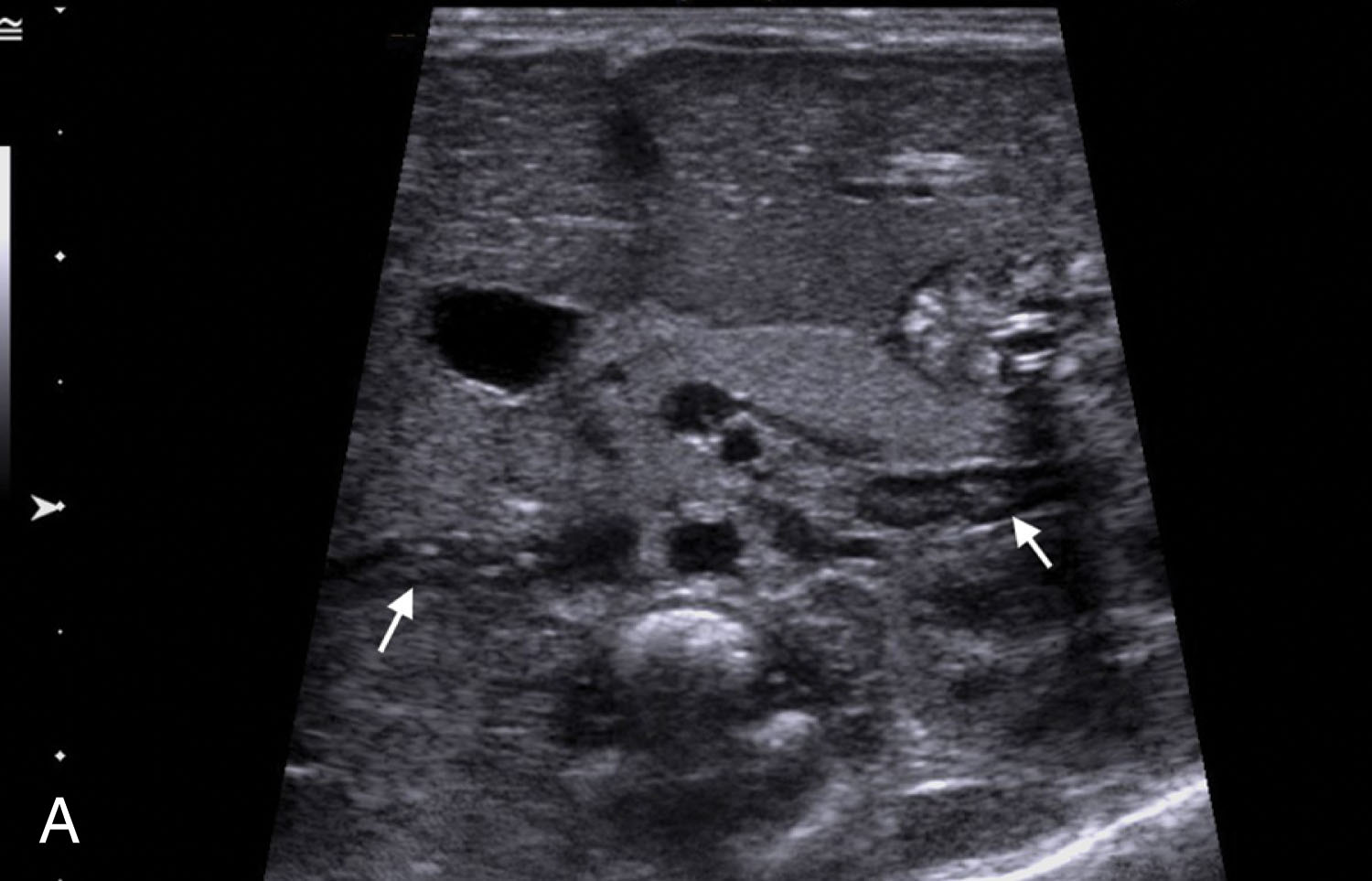
The size and texture of the liver should be evaluated ( Fig. 25.2 ). The right hepatic lobe should not extend more than 1 cm below the costal margin in a young infant without pulmonary hyperaeration and should not extend below the right costal margin in older infants and children. The echogenicity is normally low to medium homogeneity with clear definition of the portal venous vasculature. Documentation with a linear transducer over the capsule is recommended. The right hemidiaphragm and pleural space should be evaluated as well.
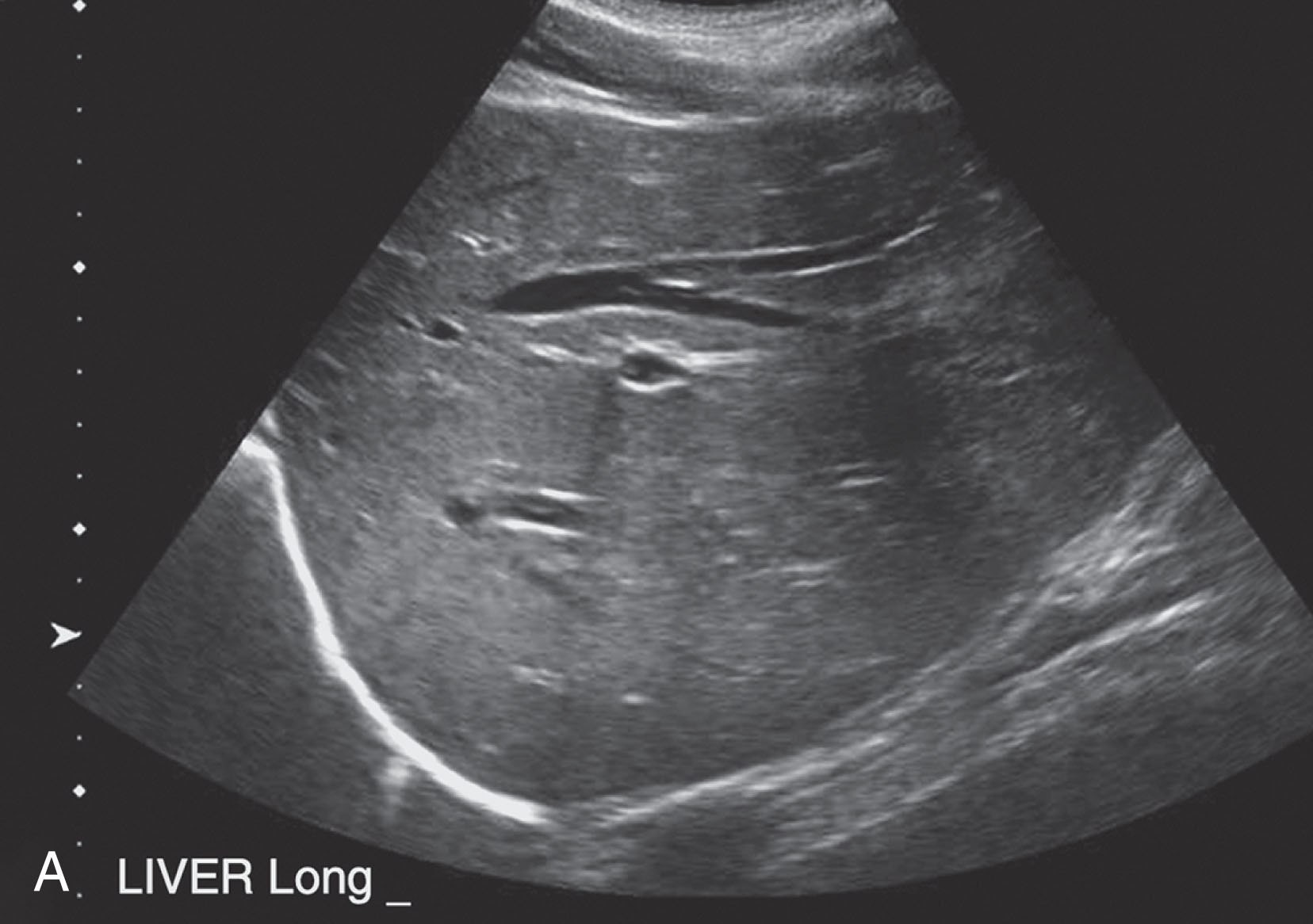
The portal vein diameter helps determine the presence of portal hypertension ( Fig. 25.3 ) and increases in size with age and weight ( Box 25.2 ). Color and pulsed wave Doppler should be used to determine flow direction and patency.
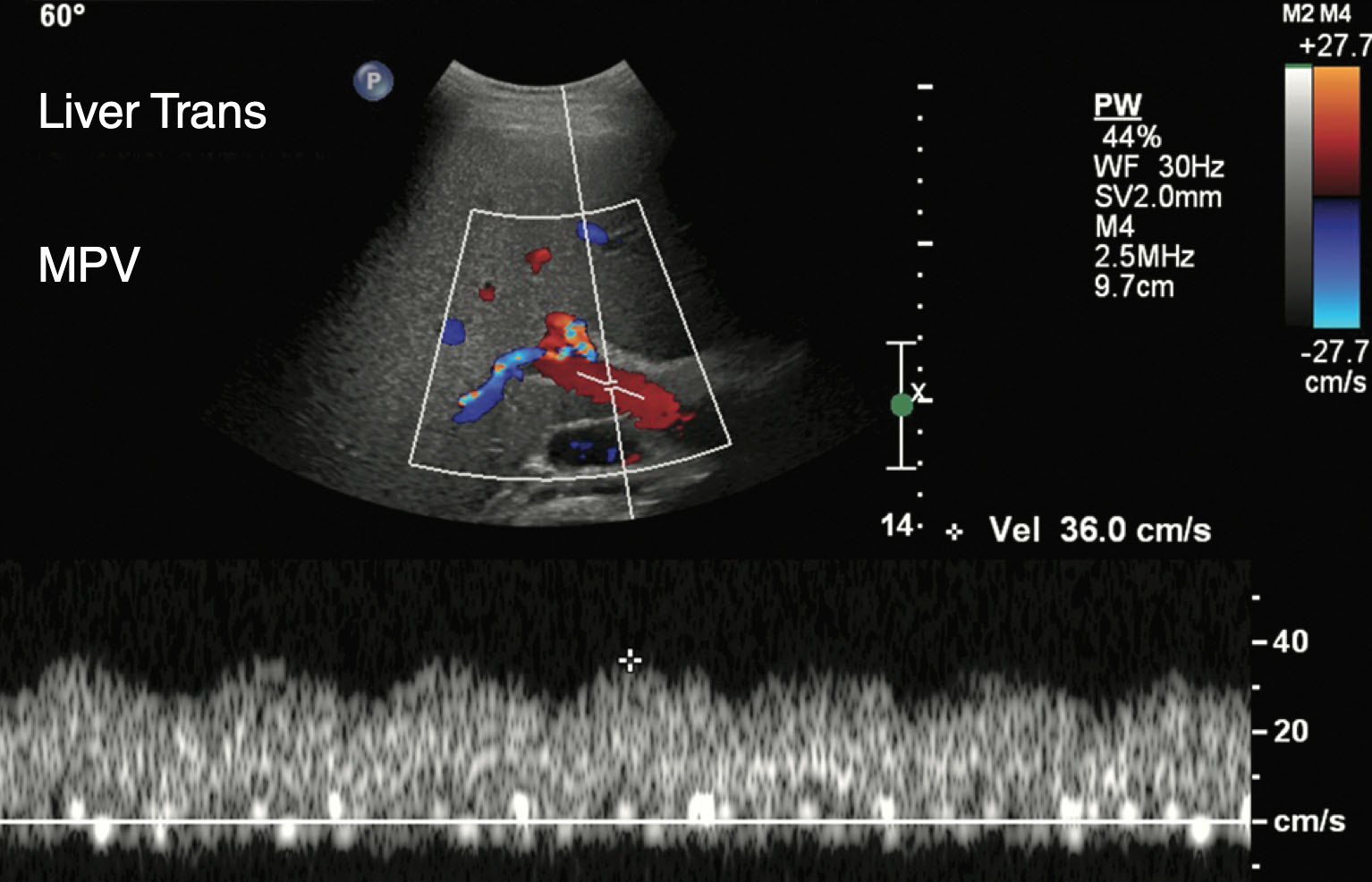
Head: 1.0–2.5 cm
Body: 0.6–1.4 cm
Tail: 1.0–2.4 cm
Duct: <2 mm
Infants: right lobe should not extend >1 cm below costal margin
Older infants and children: right lobe should not extend below right costal margin
Neonates: 3–5 mm
Children <10 years: 8.5 mm
Children >10 years: 10 mm
Adolescents ≤20 years: 7–13 mm
Neonates: CBD <1 mm
Infants (≤1 year): CBD <2 mm
Older children (1–10 years): CBD <4 mm
Adolescents: CBD <6 mm
Infants (<1 year): 1.5–3 cm
Children >1 year: 3–7 cm
Small-for-date neonates: 3.0 cm (average size)
Infants
0–3 months: ≤6 cm
3–6 months: ≤6.5 cm
6–12 months: ≤7 cm
Toddlers/preschoolers
1–2 years: ≤8 cm
2–4 years: ≤9 cm
Children
4–6 years: ≤9.5 cm
6–8 years: ≤10 cm
8–10 years: ≤11 cm
10–12 years: ≤11.5 cm
Older children
12–15 years: ≤12 cm
15–20 years: ≤12 cm (female)
15–20 years: ≤13 cm (male)
Careful evaluation of the biliary system should be made to exclude ductal dilation. The common bile duct should measure less than 1 mm in neonates, less than 2 mm in infants up to 1 year, less than 4 mm in older children, and less than 6 mm in adolescents and adults (see Box 25.2 ).
The gallbladder size and wall thickness should be assessed. In infants under one year of age, the gallbladder length is 1.5 to 3 cm, and in older children, it is 3 to 7 cm. The length of the gallbladder should not exceed the length of the kidney. The normal gallbladder should show a smooth-walled anechoic structure without internal echoes ( Fig. 25.4 ). Pericholecystic fluid should not be present.
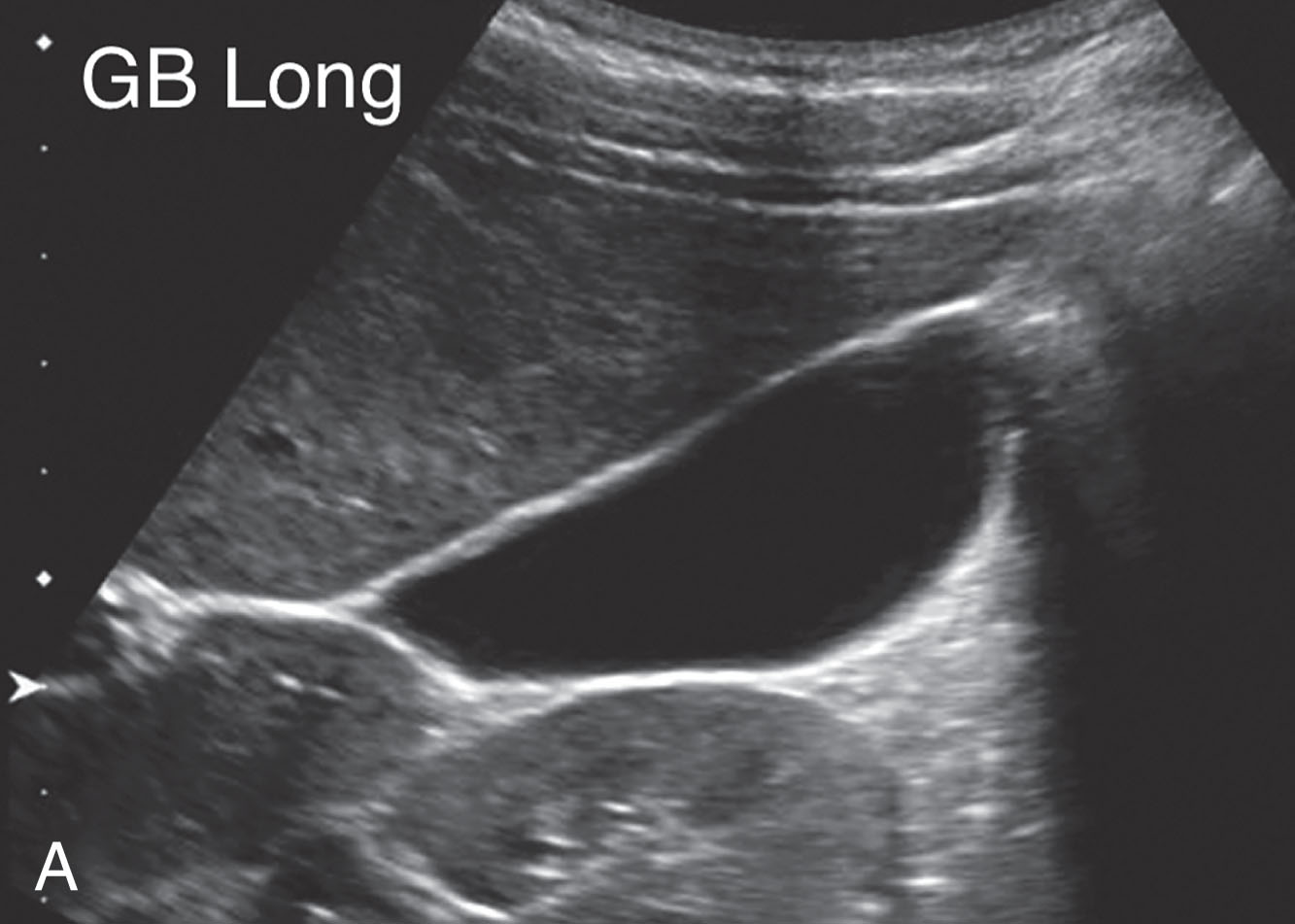
The splenic size and texture should be evaluated. Often, the stomach contents can be visualized posteriorly ( Fig. 25.5 ). The upper limits of normal splenic length range from 6.0 cm in infants less than 3 months old to 12 cm in children older than 12 years. Polysplenia, as with any anatomic anomaly, should be ruled out. The left hemidiaphragm and pleural space should be evaluated when viewing the spleen as well.
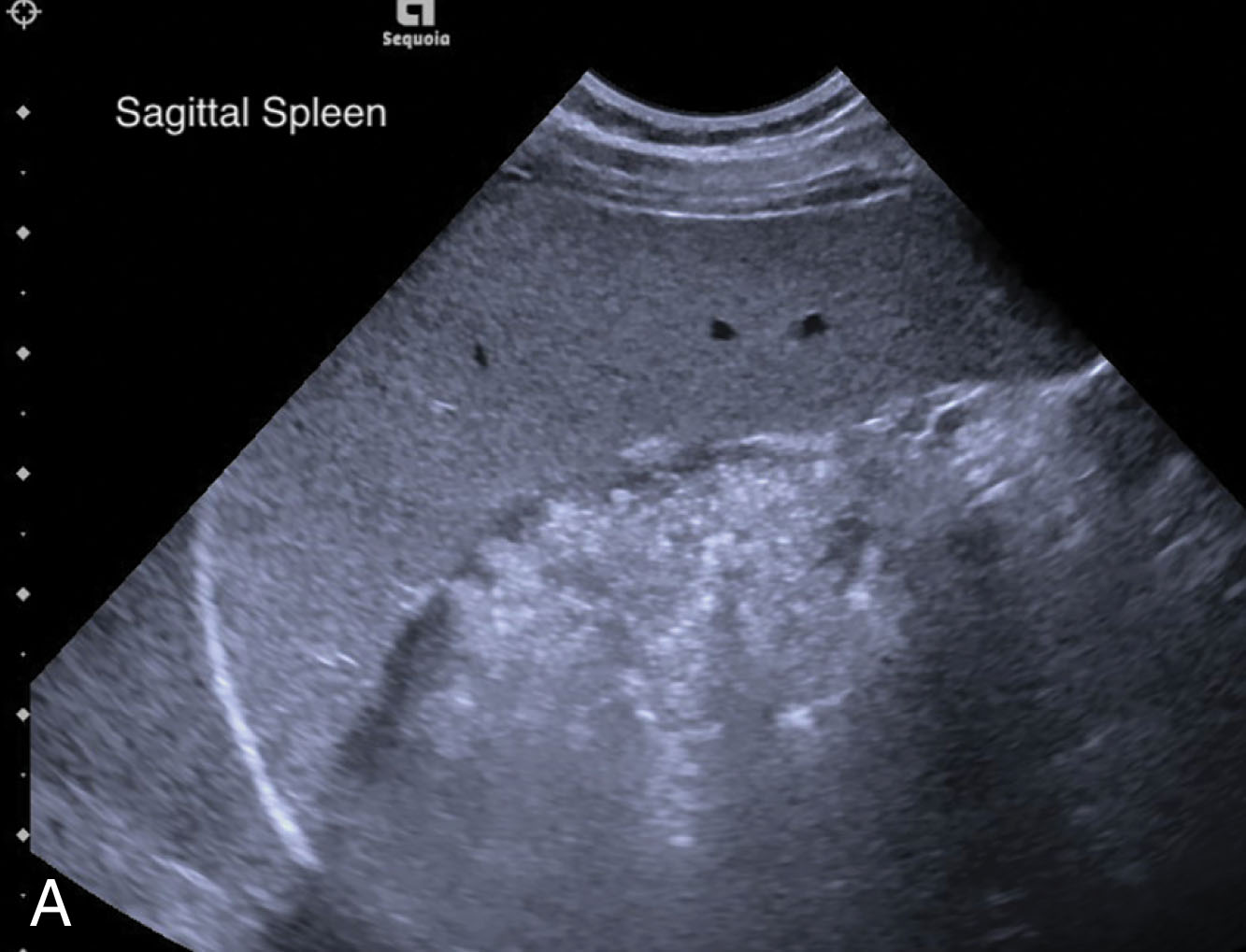
Finally, the retroperitoneal area should be closely evaluated throughout the abdominal sonographic evaluation as most malignant abdominal masses arise from the retroperitoneum in both infants and children. The inferior vena cava (IVC) and aorta vessels are documented. Proper positioning and relationship should be established to rule out situs inversus, and both vessels should be free of any thrombus. This is a critical finding. Lymph nodes are not normally visualized and abnormal when detected. They can be indicated in lymphomas, as well as malignant abdominal and pelvic masses.
Normal bowel peristalsis should be observed in the lower abdomen, and the bowel should not appear thickened. When distended, the bowel wall should measure less than 3 mm in the large bowel, and less than 2.5 mm in the small bowel. It may be up to 4 to 6 mm when collapsed. When unobstructed by gas, the normal five bowel layers, from outer serosa to inner mucosa, also called the gut signature , should be observed ( Fig. 25.6 ).
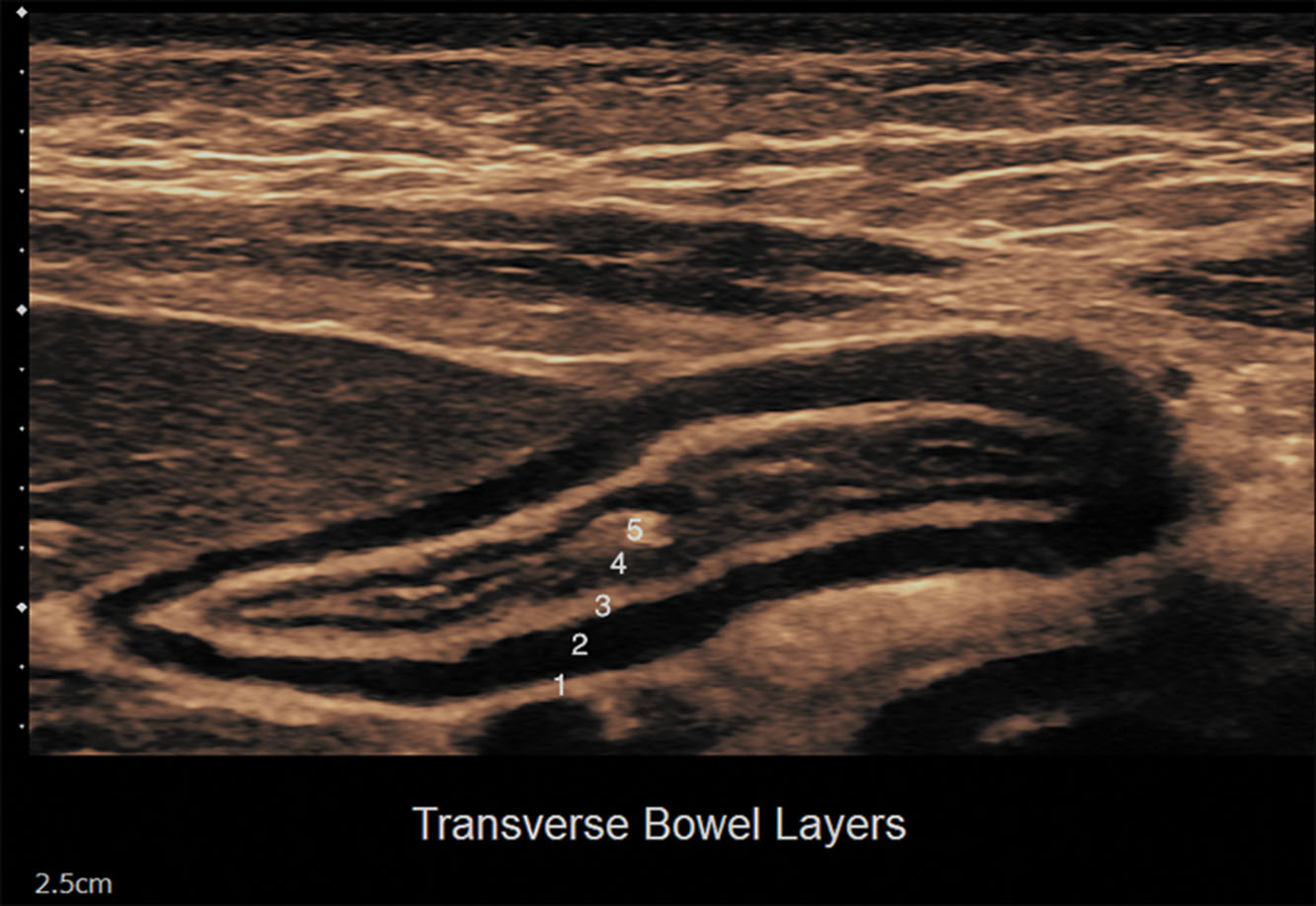
The lower abdomen should be free of any pelvic mass or free fluid. Free fluid is often abnormal, except for a little free fluid in the menstruating female or a patient with a ventriculoperitoneal shunt . If a shunt is present, the tip should be documented to rule out the development of an abdominal cerebrospinal fluid pseudocyst.
A wide variety of pathologies may be seen within the pediatric abdomen, and it is important to remember the cause may arise from any of the body’s systems. So, ruling out disease can be as important as ruling it in. Given the wide range of ages and developmental stages within the pediatric population, it is vital to be cognizant of the general disease processes as well as the sonographic appearance of the presenting pathology. Nonneoplastic disease entities of the neonatal/pediatric abdomen may be acute, chronic, congenital, or acquired.
Acute abdominal pain is one of the most common complaints among children. Many underlying surgical and nonsurgical conditions vary according to age, associated symptoms, and pain location. The most common nonsurgical condition is gastroenteritis, and the most common surgical condition is appendicitis. Gastrointestinal conditions (see Gastrointestinal Pathology later in this chapter) are often the underlying cause, but other reasons for acute abdominal pain in the child include trauma, pancreatitis, splenic sequestration, and choledocholithiasis.
Accidents (unintentional injuries) are the leading cause of mortality for children in all age groups. At ages 1 to 9 years this is followed by congenital malformations, chromosomal abnormalities, and cancer, while at ages 10 to 14 years, suicide and cancer prevail. Blunt abdominal trauma (caused by motor vehicle accidents, falling, and child abuse) may cause laceration of abdominal organs, bowel perforation, ischemia of organs due to vascular injury, and intramural hematoma. In neonates, traumatic delivery or resuscitation efforts may cause liver or splenic injury. Children have incomplete rib ossification, making the liver the most commonly injured abdominal organ versus the spleen in adults. In half of the liver cases, other abdominal organs are affected, too, especially the spleen. The pancreas ( Fig. 25.7 ) and duodenum may also be injured.
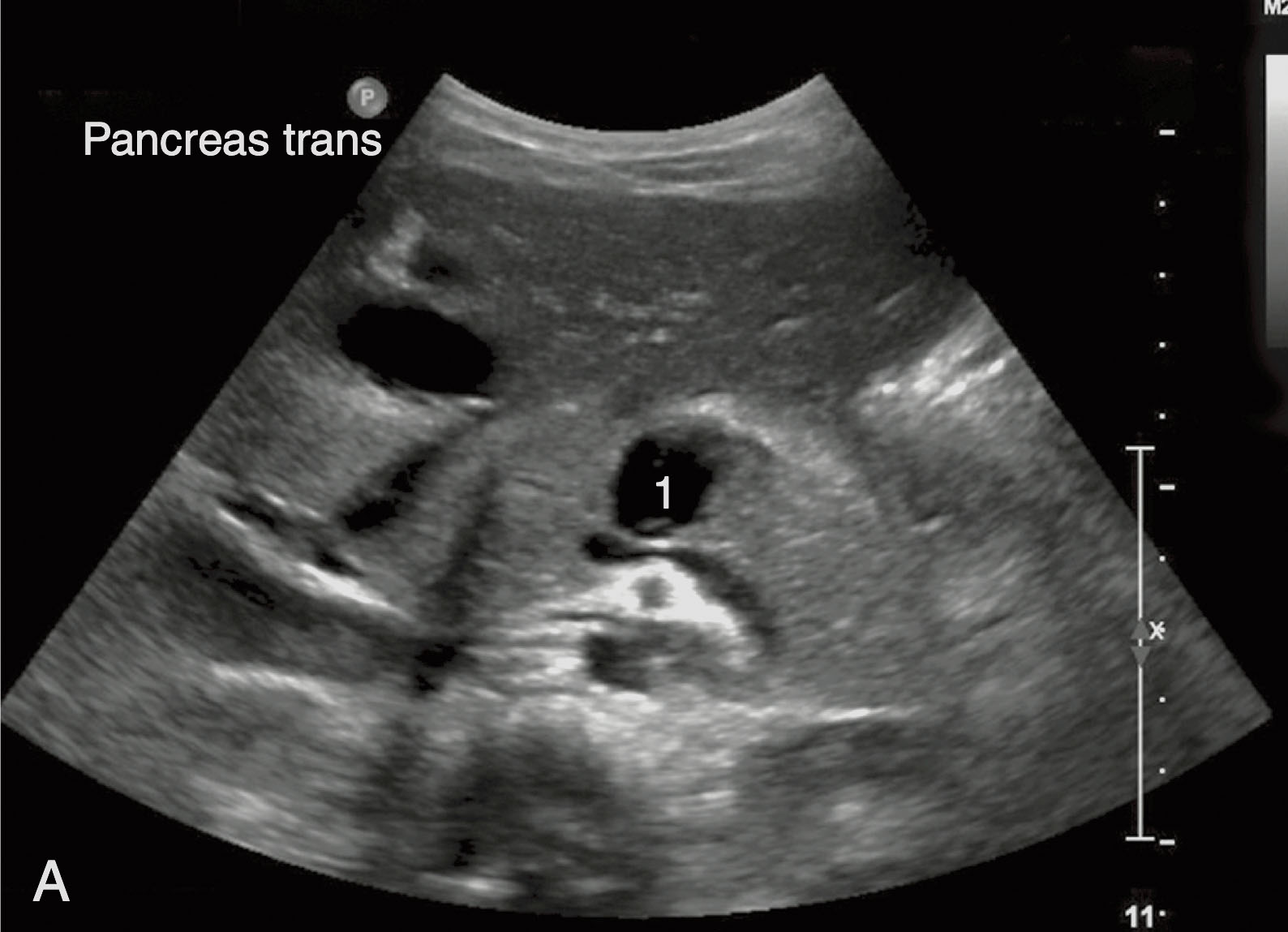
Ultrasound is often used for follow-up imaging of trauma in children. Hepatic subcapsular hematomas may be observed, as well as parenchymal hematomas, lacerations, and fractures. Liver lacerations will usually appear slightly echogenic in the acute stage and become more hypoechoic or cystic in the following days. Pseudoaneurysms and bilomas may also develop as later complications. A complex appearance and gas due to tissue necrosis and calcifications may be depicted sonographically in an aging liver hematoma.
Acute and chronic pancreatitis in childhood can cause significant morbidity and mortality. Often, acute inflammation is due to trauma or structural abnormalities, multisystemic disease, or drugs and toxins, but in nearly a quarter of children, the cause is idiopathic. Ultrasound is the imaging modality of choice in the setting of acute pancreatitis. It allows for the exclusion of extrapancreatic diseases, such as gallstones or choledocholithiasis. The most useful diagnostic finding is an enlarged pancreatic duct, which should measure less than 2 mm. Pancreatic enlargement or swelling is present in up to half of patients with acute pancreatitis. Peripancreatic fluid and fluid collections (pseudocysts), as well as peripancreatic fatty infiltration, may be present.
Chronic inflammation of the pancreas is more often caused by CF (see Acquired and Hereditary Diseases later in this chapter), fibrosing pancreatitis, hereditary chronic pancreatitis, or inborn errors of metabolism. In chronic pancreatitis, the pancreas may appear echogenic with calcifications, both shadowing and nonshadowing.
Splenic sequestration syndrome presents with rapid splenic enlargement and an acute fall in hematocrit. It causes extreme pain and, if left untreated, can be fatal. Often, it occurs in children younger than 2 years with sickle cell disease, but it can occur in older children with blood disorders or neonates/infants on extracorporeal membrane oxygenation (ECMO) . Ultrasound will reveal a grossly enlarged spleen with peripheral low echogenicity foci (corresponding to hemorrhage on magnetic resonance imaging), but internal blood flow will be preserved.
The incidence of gallstones in children, though still uncommon, has been increasing over the past few decades. The widespread use of ultrasound in detecting asymptomatic cholelithiasis and increasing childhood obesity are key reasons for this trend. In neonates and infants, causes of cholelithiasis or choledocholithiasis include sepsis, total parenteral nutrition, and diuretics. Fetal gallstones, however, will often resolve spontaneously within the first year of life. In older children, causes include hemolytic anemia (such as sickle cell disease), CF, and small bowel diseases. Echogenic foci may be detected within the lumen of the gallbladder or anywhere along the biliary tract. Distal ductal dilation may be present as well. Documenting gallstone mobility is encouraged. Since up to half of pediatric biliary stones are calcified, especially among those with hemolytic disease, color Doppler may aid in producing a “twinkle” artifact in a nonmobile focus. This artifact is best produced by increasing the color Doppler scale and the color gain.
Acquired and hereditary diseases need to be carefully monitored and screened in the pediatric population. Some hereditary diseases may predispose an infant or child to develop certain cancers (e.g., Beckwith-Wiedemann syndrome’s increased risk of hepatoblastoma) and/or chronic conditions (e.g., CF’s high association with chronic pancreatitis). These abdominal disorders, common in children, are described here.
Once only seen in adults, NAFLD is now considered one of the most prevalent chronic liver diseases in children, with an estimated 3% to 10% of the pediatric population affected (mostly adolescents). This increase is directly linked to increased obesity among children and resulting fatty deposition within the liver. It may lead to nonalcoholic steatohepatitis . Sonographically, the same four general categories of fatty liver classification (absent, mild, moderate, and severe) are used in children, as with adults.
Although less common than in their adult counterparts, cirrhosis and portal hypertension are found in the pediatric population. The cause of cirrhosis in children is often divided into four categories: (1) biliary (biliary atresia, Alagille syndrome, alpha-1 antitrypsin deficiency, and CF); (2) metabolic (errors resulting in excessive copper buildup with Wilson disease, or excessive iron buildup with hemochromatosis); (3) postnecrotic cirrhosis (neonatal, postviral, or autoimmune hepatitis); and (4) unknown causes. Sonographically, cirrhosis displays the same adult characteristics, such as abnormal liver surface, with increased echogenicity and nodular changes of the parenchyma being the most specific.
Become a Clinical Tree membership for Full access and enjoy Unlimited articles
If you are a member. Log in here